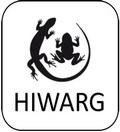About us
About Us
Hampshire is fortunate that the county covers a huge geographic area and a very diverse breadth of habitat including: the Isle of Wight, the New Forest National Park, the South Downs National Park, as well as many other unspoiled areas, including Woolmer Forest.
It is therefore unsurprising that we are host to 12 out of the 13 native amphibians and reptiles in UK, including rarities such as the Natterjack Toad, Sand Lizard and Smooth Snake, and wherever you live in the county there will be opportunities to survey and monitor an assemblage of amphibian and reptile species.
HIWARG formed in the Autumn of 2018 and is an affiliated independent ARG-UK group. The group focus is conservation of native UK species essentially around habitat management, surveying, public engagement, volunteer training & doing as much as possible to understand & protect the native species in the county.
All members are volunteers with a common interest.
If you have some spare time and would like to be involved with HIWARG, maybe you have taken a photo of a reptile or amphibian and would like it identified or maybe you have some other query, then please do get in contact info@hiwarg.org.uk
CONSERVATION THROUGH EMPATHY BY ENGAGEMENT
Visit HIWARG's Redbubble Shop to support our work www.redbubble.com/people/HIWARG/shop
News
News
Midwife Toads in the Winchester (Littleton, Weeke and Teg Down areas in particular) and possibly Colden Common areas
Despite the lack of records, there is an anecdotal comment to suggest that Midwife Toads were known from the Winchester area and so we are reaching out to residents for their help in finding these elusive toads. By far the best way to identify the presence of Midwife Toads is by their calls, which has been likened to “an electronic beep, like a smoke alarm with a dying battery or a New Age car alarm” by Steve Allain, one of the lead national researchers of Midwife Toads.
With tonights drizzling rain, it is more likely that they will start calling if thay are still around. Visit the following links to hear a sample of Midwife Toads calling
http://stevenallain.co.uk/.../scifri-whats-that-beeping...
www.youtube.com/watch?v=SVPK899UwV8
Midwife Toads are smaller than our native toads, with adults reaching around 5cm in length. They can also be distinguished by their eyes, if you are lucky enough to spot one, which have vertical pupils as opposed to horizontal/oval pupils of our two native toads. A big difference with these toads is that they are not as reliant on ponds for breeding, as the male toads carry the eggs wrapped around their back legs, hence their name. Breeding usually takes place between April and June so they should have been calling for a few weeks now, but the dry weather may have affected this..
We are hoping that residents in the Winchester area (especially Littleton, Weeke and Teg Down) will be willing to help by listening out on warm damp nights for the “beeping” toads. If you do hear these calls it would be really helpful if you can record the calls on your phone, or take photos if you manage to see one.
For all sightings/recordings, please contact us on:
HIWARG Amphibian Officer: amphibians@hiwarg.org.uk or HIWARG on Facebook www.facebook.com/groups/455730808110700
Steve Allain: www.facebook.com/SJRAllain or https://twitter.com/stevoallain
Midwife Toads in Hampshire 2023
Midwife Toads are not a native species to the UK, but have been found in several colonies in parts of the country. Hampshire has been named as one of these locations in several sources, but there are no actual records that we are aware of. Despite the lack of records, there is an anecdotal comment to suggest that Midwife Toads were known from the Littleton area and so we are reaching out to residents for their help in recording these elusive toads.
Midwife Toads are smaller than our native toads, with adults reaching around 5cm in length. They can also be distinguished by their eyes, if you are lucky enough to spot one, which have vertical pupils as opposed to horizontal/oval pupils of our two native toads. By far the best way to identify the presence of Midwife Toads is by their calls, which has been likened to “an electronic beep, like a smoke alarm with a dying battery or a New Age car alarm” by Steve Allain, one of the lead national researchers of Midwife Toads. A big difference with these toads is that they are not as reliant on ponds for breeding, as the male toads carry the eggs wrapped around their back legs, hence their name. Breeding usually takes place between April and June so they should have been calling for a few weeks now. Visit Steve’s blog to hear a sample of Midwife Toads calling http://stevenallain.co.uk/.../scifri-whats-that-beeping... you can also hear individual calls on this Youtube link www.youtube.com/watch?v=SVPK899UwV8
We are hoping that residents in the Winchester area (especially Littleton, Weeke and Teg Down) will be willing to help both Steve Allain and HIWARG, by listening out on warm damp nights for the “beeping” toads. If you do hear these calls it would be really helpful if you can record the calls on your phone, or take photos if you manage to see one.
For all sightings/recordings, please contact us on:
HIWARG Amphibian Officer: amphibians@hiwarg.org.uk or HIWARG on Facebook www.facebook.com/groups/455730808110700
Steve Allain: www.facebook.com/SJRAllain or https://twitter.com/stevoallain
Stuck for something to do over the Easter Weekend?
Big Green Frog Hunts are more exciting, than Easter egg hunts (although maybe not as tasty).
Conditions are not the best, but with sunny spells and temperatures tickling the 'teens over the weekend, the chances of spotting water frogs are on the increase. Pack a picnic, check the area on the map below and go for a walk. Take a camera and record your sightings and photos on www.recordpool.org.uk
Water frogs are non-native frogs in the Pelophylax group. They are a tricky group to ID to species accurately in the field so we typically call them water frogs.
As they are a complex of species, adult size can range from a similar build to our common frogs up to 50% larger. Other ID features are:
- A very rounded nose/jaw, almost conical;
- Eyes are more prominant and closer together than on common frogs;
- They lack the "bandit" eye patch behind the eyes, as with common frogs;
- Can have a yellow/green line down their spine, but not always present/obvious;
- Lateral ridges on either side of their back;
- Almost always in or close to water, often basking in the sun;
- Will almost always spot you first, jumping into the water and disappearing immediately;
- Calling males will have two vocals sacs, either side of their jaw. (common frogs call with their throat.)
- Male calls sound like a cackling, croaking, quacking sound... they can sometimes be called laughing frogs.
We have four water frogs in our area, Marsh frog, Edible frog, Southern clade pool frog and Perez's frog. The following video will give you a rough idea of what to look for and hopefully listen out for: www.youtube.com/watch?v=472zFshwasA
You can download a fab ID guide at www.arguk.org/info-advice/id-guides/441-amphibian-id-guide-revised-2019-pdf
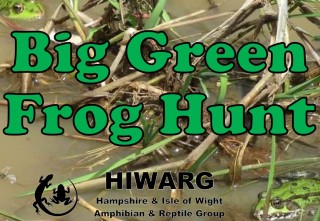


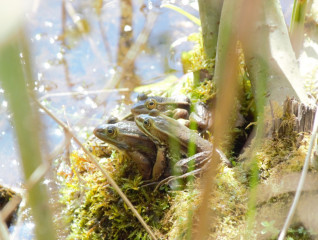
Toads need your help
Toads and other amphibians have started migrating to their breeding ponds, but often get killed on our roads. There are three registered toad crossings on Froglife's Toads on Roads Map, but only two are manned by patrollers. If you can help save toads and other amphibians by becoming a Toad Patroller, visit https://www.froglife.org/what-we-do/toads-on-roads/tormap/ and find your nearest crossing.
If you want to know what Toad Patrols do, you can read more here https://www.froglife.org/wp-content/uploads/2023/01/Patrol-Pack-2023-compressed_compressed.pdf
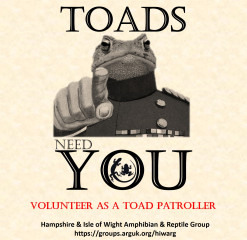
Amphibian survey training
Following the increased amphibian activity with this mild weather I am thinking of starting some of our survey and ID training for members a little earlier.
If you are a HIWARG member, check your email address that you used to join with. I will be sending out a generic email to all members on how to access training and I will be sending provisional dates to all current amphibian surveyors and those waiting training.
If you are not a member, but are interested in becoming a HIWARG amphibian surveyor click the 'Join up' tag above.
Join up or Log In
Join up or Log In
Members sign in here

OR
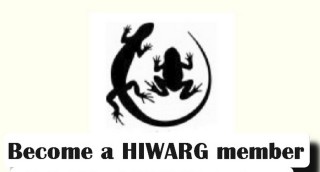
Membership costs just £6.00 per year as a subscription that can be cancelled at any time.
Your membership will help HIWARG to protect the amphibians & reptile of Hampshire.
Be aware of and take part in conservation opportunities, surveys and many other activities across the county.
Click here to go directly to PayPal to subscribe as a member:
Donate to HIWARG
Donate to HIWARG
Info & ID guides
Info & ID guides
Policies/Health & Safety
HIWARG Safeguarding Policy and Protocols June 2020
Buddy System/Lone Working Procedures
ARG UK Generic Risk Assessment July2020
Identification Guides
Amphibian Identification - downloadable colour cards : a great ID guide from ARG UK/ARC
Newt Eggs & Larvae - downloadable colour cards : an excerpt from the above guide, specifically on newt eggs and larvae
Its a small newt but which one : a HIWARG guide to help differentiate smooth newts and palmate newts
Reptile Identification - downloadable colour cards : a great ID guide from ARG UK/ARC
Non-Native Species ID Sheets (NNSS Website) : ID sheets from the Non Native Species Secretariat
Alien Amphibian and Reptile Species in the UK : A bilingual guide (English/Welsh) from ARC
Advice and Information
ARC's "Dogs and Adders" Advice Sheet
"There is a Snake in my Garden - What can I do?" (ARG UK)
Projects & Citizen Science
DARN's 'Slow Worms in Churchyards' project
'Amphibians & Reptiles on Allotments' Introduction Leaflet
"Spawn Spotters" presentation 12 Jan 2021
Toad Patrol presentation 12 Jan 2021
Gotta love a larva presentation 9 July 2021
HIWARG Video: Spawn Spotters and Toad Patrols Jan 2021
HIWARG Video: Amphibian surveys: ID'S & Survey Methods March 2021
Habitat Management and Creation
![]() Reptile Habitat Management Handbook
Reptile Habitat Management Handbook
![]() Amphibian Habitat Management Handbook
Amphibian Habitat Management Handbook
Creating Garden Ponds - downloadable booklet
Creating Ponds for Amphibians and Reptiles (Freshwater Habitats Trust)
Guide to the Restoration, Creation and Management of Ponds (Freshwater Habitats Trust)
Habitat Management guides (Buglife) - Not specifically herp based but a great set of guides
How to Create Invertebrate and Reptile Mounds (Magnificent Meadows)
Creating Grass Snake Egg-laying Heaps (ARG UK and RAVON)
Herp Diseases - Recognise & Report
REPORT SICK OR DEAD WILDLIFE TO GARDEN WILDLIFE HEALTH
Advice Note-4: Amphibian disease precautions - a guide for UK fieldworkers
Reptile Slough Genebank - collection & submission of found sloughs
Garden Wildlife Health - Severe Perkinsea Infection (SPI)
Other
Fixing Enkamat to Gully Pots - Initial Findings in Sussex
Useful glossary of terms often used within the herpetological field. (Credit due - unknown)
Kids stuff - Educational items for the young ones
Pond pack Animal fact sheets Animal colouring sheets
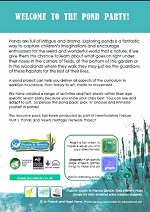

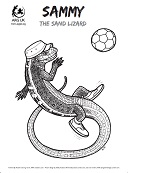
Photo gallery
Photo Gallery
Contact us
Contact Us
If you would like more information about HIWARG or have something to share with us, please get in touch via the link to our social media presence.
Upcoming Events
Upcoming events will be listed here.
Latest News
- Midwife Toads in the Winchester (Littleton, Weeke and Teg Down areas in particular) and possibly Colden Common areas
18/06/2023 8:11 pm - Midwife Toads in Hampshire 2023
19/04/2023 11:05 pm - Stuck for something to do over the Easter Weekend?
05/04/2023 11:20 pm - Toads need your help
21/02/2023 12:23 am - Amphibian survey training
08/01/2023 11:43 am
© Hampshire And Isle of Wight Amphibian and Reptile Group (HIWARG)
Website hits: 41210
View All | Find out how to get a mini-website for your ARG
© ARG UK Local Groups mini-websites 2024
Wind powered websites by Aye-aye Design.
